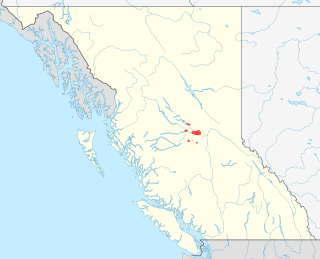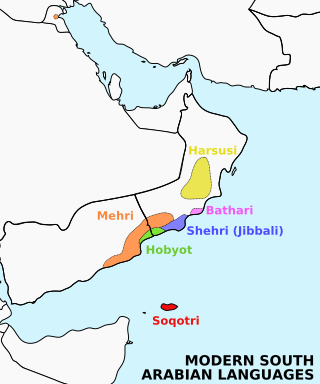Related Research Articles
In linguistics, morphology is the study of words, how they are formed, and their relationship to other words in the same language. It analyzes the structure of words and parts of words such as stems, root words, prefixes, and suffixes. Morphology also looks at parts of speech, intonation and stress, and the ways context can change a word's pronunciation and meaning. Morphology differs from morphological typology, which is the classification of languages based on their use of words, and lexicology, which is the study of words and how they make up a language's vocabulary.

Burushaski is a language isolate spoken by Burusho people, who reside almost entirely in northern Gilgit-Baltistan, Pakistan, with a few hundred speakers in northern Jammu and Kashmir, India. In Pakistan, Burushaski is spoken by people in Hunza District, Nagar District, northern Gilgit District, the Yasin valley in the Gupis-Yasin District and the Ishkoman valley of the northern Ghizer District. Their native region is located in northern Gilgit–Baltistan and borders with the Pamir corridor to the north. In India, Burushaski is spoken in Botraj Mohalla of the Hari Parbat region in Srinagar. Other names for the language are Biltum, Khajuna, Kunjut, Brushaski, Burucaki, Burucaski, Burushaki, Burushki, Brugaski, Brushas, Werchikwar and Miśa:ski.

Northern Bavarian is a dialect of Bavarian, together with Central Bavarian and Southern Bavarian. Bavarian is mostly spoken in the Upper Palatinate, although not in Regensburg, which is a primarily Central Bavarian–speaking area, according to a linguistic survey done in the late 1980s. According to the same survey, Northern Bavarian is also spoken in Upper Franconia, as well as in some areas in Upper and Lower Bavaria, such as in the areas around Eichstätt and Kelheim. Few speakers remained in the Czech Republic, mostly concentrated around Aš and Železná Ruda, at the time of the survey, but considering the time which has passed since the survey, the dialect may be extinct in those places today. If it still exists there, it would include the ostegerländische Dialektgruppe. Ethnologue estimates that there were 9,000 speakers of Bavarian in the Czech Republic in 2005, but does not clarify if these were Northern Bavarian speakers.

The Munda languages are a group of closely related languages spoken by about nine million people in India and Bangladesh. Historically, they have been called the Kolarian languages. They constitute a branch of the Austroasiatic language family, which means they are more distantly related to languages such as the Mon and Khmer languages, to Vietnamese, as well as to minority languages in Thailand and Laos and the minority Mangic languages of South China. Bhumij, Ho, Mundari, and Santali are notable Munda languages.

Greenlandic is an Eskimo–Aleut language with about 56,000 speakers, mostly Greenlandic Inuit in Greenland. It is closely related to the Inuit languages in Canada such as Inuktitut. It is the most widely spoken Eskimo–Aleut language.
The Nandi language, or Kalenjin proper, are a dialect cluster of the Kalenjin branch of the Nilotic language family.
In linguistics, especially within generative grammar, phi features are the morphological expression of a semantic process in which a word or morpheme varies with the form of another word or phrase in the same sentence. This variation can include person, number, gender, and case, as encoded in pronominal agreement with nouns and pronouns. Several other features are included in the set of phi-features, such as the categorical features ±N (nominal) and ±V (verbal), which can be used to describe lexical categories and case features.

The Dakelh (ᑕᗸᒡ) or Carrier language is a Northern Athabaskan language. It is named after the Dakelh people, a First Nations people of the Central Interior of British Columbia, Canada, for whom Carrier has been a common English name derived from French explorers naming of the people. Dakelh people speak two related languages. One, Babine-Witsuwit'en is sometimes referred to as Northern Carrier. The other includes what are sometimes referred to as Central Carrier and Southern Carrier.

South Bolivian Quechua, also known as Central Bolivian Quechua, is a dialect of Southern Quechua spoken in Bolivia and adjacent areas of Argentina, where it is also known as Colla. It is not to be confused with North Bolivian Quechua, which is spoken on the northern Andean slopes of Bolivia and is phonologically distinct from the South Bolivian variety. Estimates of the number of speakers of South Bolivian Quechua range from 2.3 to 2.8 million, making it the most spoken indigenous language in Bolivia, just slightly greater than Aymara, with roughly 2 million speakers in Bolivia. In comparison, the North Bolivian dialect has roughly 116,000 speakers.

Sora is a south Munda language of the Austroasiatic language of the Sora people, an ethnic group of eastern India, mainly in the states of Odisha and Andhra Pradesh. Sora contains very little formal literature but has an abundance of folk tales and traditions. Most of the knowledge passed down from generation to generation is transmitted orally. Like many languages in eastern India, Sora is listed as 'vulnerable to extinction' by UNESCO. Sora speakers are concentrated in Odisha and Andhra Pradesh. The language is endangered as per as International Mother Language Institute (IMLI).

Korku is an Austroasiatic language spoken by the Korku tribe of central India, in the states of Madhya Pradesh and Maharashtra. It is isolated in the midst of the Gondi people, who are Dravidian, while its closest relatives are in eastern India. It is the westernmost Austroasiatic language.

The Tati language is a Northwestern Iranian language which is closely related to the Talysh, Mazandarani and Gilaki languages spoken by the Tat people of Iran. It is, for the most part, mutually intelligible with Persian. Tats are a subgroup of Northwestern Iranians.
The Gtaʼ language, also known as Gta Asa, Didei or Didayi, is an Austroasiatic language spoken by the Didayi people of southernmost Odisha in India. It is notable for its sesquisyllabic phonology and vigesimal numeral system.

Shehri,, also known as Jibbali, is a Modern South Arabian language. It is spoken by a small native population inhabiting the coastal towns and the mountains and wilderness areas upland from Salalah, located in the Dhofar Governorate in southwestern Oman.
Odia grammar is the study of the morphological and syntactic structures, word order, case inflections, verb conjugation and other grammatical structures of Odia, an Indo-Aryan language spoken in South Asia.

In linguistic morphology, inflection is a process of word formation in which a word is modified to express different grammatical categories such as tense, case, voice, aspect, person, number, gender, mood, animacy, and definiteness. The inflection of verbs is called conjugation, and one can refer to the inflection of nouns, adjectives, adverbs, pronouns, determiners, participles, prepositions and postpositions, numerals, articles, etc., as declension.
Temoaya Otomi, also known as Toluca Otomi or Otomi of San Andrés Cuexcontitlan, is a variety of the Otomi language spoken in Mexico by ca. 37,000 people in and around the municipality of Temoaya, and in three communities within the municipality of Toluca: San Andrés Cuexcontitlán, San Pablo Autopan and San Cristobal Huichochitlan. The two varieties are quite different. The speakers themselves call the language Ñatho. Lastra (2001) classifies it as a southwestern dialect along with the dialects of Mexico state. Lastra also notes that the endangered Otomí dialect of San Felipe in eastern Michoacán is most similar to the Otomí spoken in San Andrés Cuexcontitlan.
Mingrelian is a Kartvelian language that is mainly spoken in the Western Georgian regions Samegrelo and Abkhazia. In Abkhazia the number of Mingrelian speakers declined dramatically in the 1990s as a result of heavy ethnic cleansing of ethnic Georgians, the overwhelming majority of which were Mingrelians.

The Yukulta language, also spelt Yugulda, Yokula, Yukala, Jugula, and Jakula, and also known as Ganggalidda, is an extinct Tangkic language spoken in Queensland and Northern Territory, Australia. It was spoken by the Yukulta people, whose traditional lands lie on the southern coast of the Gulf of Carpentaria.
Nuaulu is a language indigenous to the island of Seram Island in Indonesia, and it is spoken by the Nuaulu people. The language is split into two dialects, a northern and a southern dialect, between which there a communication barrier. The dialect of Nuaulu referred to on this page is the southern dialect, as described in Bolton 1991.
References
- ↑ Juray at Ethnologue (25th ed., 2022)

- 1 2 Anderson, Gregory; Gomango, Opino. "On the current status and state of Juray in the Sora-Juray cluster". FEL 20: 103–109.